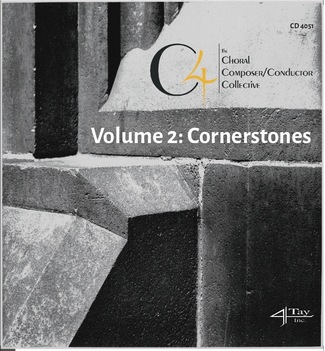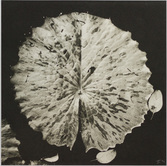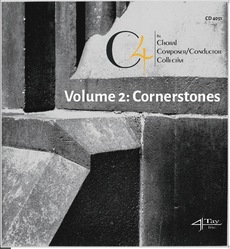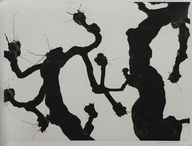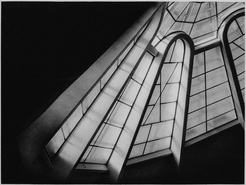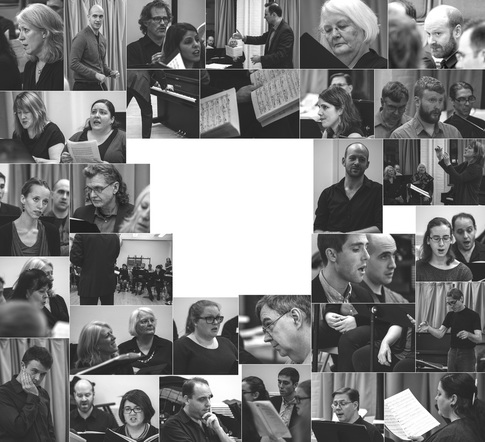C4 Volume 2: CornerstonesFull MP3 Album (13 tracks) $12.00
|
Saylor - The Spheres at Play, All Three Movements - MP3 $2.97
Allégories, all three movements - MP3 - $2.98
Hersant - Allégories - Départ - MP3 - $0.99
The Music on C4 Volume 2: Cornerstones
(in order of appearance on the CD)

The Spheres at Play by Bruce Saylor on text of Emily Dickinson
1. There Came a Wind Like a Bugle 2:20
2. Put Up My Lute! 2:45
3. Musicians Wrestle Everywhere 2:52
Conductor: Timothy Brown
I wrote “The Spheres At Play” choruses in 2001, in the stand-alone version we hear tonight, in response to a commission from the Nashville Symphony for a chorus and orchestral work, premiered in April of 2002. In my libretto for the Nashville piece, these Emily Dickinson poems about music and sound open like “windows” onto my selections from the vast Civil War visions of Walt Whitman’s “Proud Music of the Storm.” In Dickinson’s astonishing poetic evocation of the violent furies of nature, of the mysterious sounds emanating from Pharaonic Colossi of Memnon which might awaken a fallen beloved, and of her “music of the spheres”—the invisible form of vibrations coursing through both air and matter—the poet creates a sound-world of her own which I have felt privileged to set to music. These a cappella choruses were given their first performance by The New Chamber Singers in Rome under my direction in 2001. But absolutely nothing can compare with the intense, committed, and intricately crafted performances by the amazing C4.
—Bruce Saylor
For more information on Bruce Saylor, click (coming soon)
1. There Came a Wind Like a Bugle 2:20
2. Put Up My Lute! 2:45
3. Musicians Wrestle Everywhere 2:52
Conductor: Timothy Brown
I wrote “The Spheres At Play” choruses in 2001, in the stand-alone version we hear tonight, in response to a commission from the Nashville Symphony for a chorus and orchestral work, premiered in April of 2002. In my libretto for the Nashville piece, these Emily Dickinson poems about music and sound open like “windows” onto my selections from the vast Civil War visions of Walt Whitman’s “Proud Music of the Storm.” In Dickinson’s astonishing poetic evocation of the violent furies of nature, of the mysterious sounds emanating from Pharaonic Colossi of Memnon which might awaken a fallen beloved, and of her “music of the spheres”—the invisible form of vibrations coursing through both air and matter—the poet creates a sound-world of her own which I have felt privileged to set to music. These a cappella choruses were given their first performance by The New Chamber Singers in Rome under my direction in 2001. But absolutely nothing can compare with the intense, committed, and intricately crafted performances by the amazing C4.
—Bruce Saylor
For more information on Bruce Saylor, click (coming soon)
|
There Came a Wind Like a Bugle
There came a Wind like a Bugle; It quivered through the Grass, And a Green Chill upon the Heat So ominous did pass We barred the Windows and the Doors As from an Emerald Ghost; The Doom’s electric Moccasin That very instant passed. On a strange Mob of panting Trees, And Fences fled away, And Rivers where the Houses ran Those looked that lived that Day. The Bell within the steeple wild The flying tidings told, How much can come And much can go, And yet abide the World! |
Put Up My Lute!
Put Up My lute! What of my Music! Since the sole ear I care to charm, Passive as Granite, laps my Music, Sobbing, will suit as well as psalm! Would that the Memnon of the Desert Teach me the strain That vanquished Him When He surrendered to the Sunrise. Maybe that would awaken them! |
Musicians Wrestle Everywhere
Musicians wrestle everywhere: All day, among the crowded air, I hear the silver strife; And—waking long before the morn-- Such transport breaks upon the town I think it that “New Life”! It is not Bird, it has no nest; Nor Band, in brass and scarlet dressed, Nor Tambourine, nor Man; It is not Hymn from pulpit read,-- The “Morning Stars” the Treble led On Time’s first Afternoon! Some say it is the Spheres at play! Some say that bright Majority Of vanished Dames and Men! Some think it service in the place Where we, with late, celestial face, Please God, shall Ascertain! |

4. Pitter patter, pitter patter; and then 5:09
by Daniel Andor-Ardó on text of Zsuzsanna Ardó
Conductor: Timothy Brown
Tenor duo: Mario Gullo and Colin Britt;
Quartet: Martha Sullivan, Melissa Bybee, Nathaniel Barnett, Hayes Biggs
I composed the piece over three years ago, based on a poem by Zsuzsanna Ardó that was in turn inspired by events nearly a century ago. And yet, the narrative has a strong resonance with the ongoing refugee crisis today.
The music follows the story of the character of the Dwarf, which falls into three sections. At first, the Dwarf finds herself caught in a storm that floods the forest and is threatening to drown her. Then, in desperation, she appeals to the Rainbow for refuge: “Will you take me?” And then, we hear the answer: “No. I don’t know you.”
Starting with the “pitter patter” of a summer drizzle, the piece builds and shifts rhythmic gears multiple times before reaching hurricane force.
In this way the music mirrors the process of social exclusion, which can start innocuously and morph imperceptibly into an unrecognizable, tragic new reality.
—Daniel Andor-Ardó
For more information about Daniel Andor-Ardó, click HERE
by Daniel Andor-Ardó on text of Zsuzsanna Ardó
Conductor: Timothy Brown
Tenor duo: Mario Gullo and Colin Britt;
Quartet: Martha Sullivan, Melissa Bybee, Nathaniel Barnett, Hayes Biggs
I composed the piece over three years ago, based on a poem by Zsuzsanna Ardó that was in turn inspired by events nearly a century ago. And yet, the narrative has a strong resonance with the ongoing refugee crisis today.
The music follows the story of the character of the Dwarf, which falls into three sections. At first, the Dwarf finds herself caught in a storm that floods the forest and is threatening to drown her. Then, in desperation, she appeals to the Rainbow for refuge: “Will you take me?” And then, we hear the answer: “No. I don’t know you.”
Starting with the “pitter patter” of a summer drizzle, the piece builds and shifts rhythmic gears multiple times before reaching hurricane force.
In this way the music mirrors the process of social exclusion, which can start innocuously and morph imperceptibly into an unrecognizable, tragic new reality.
—Daniel Andor-Ardó
For more information about Daniel Andor-Ardó, click HERE
|
Pitter patter, pitter patter... And then.
Pitter-patter. Pitter-patter. Pitter-patter. Then. Then. Then. Pitter-patter. Pitter-patter. Pitter-patter. Then. Then. Then. Pitter-patter. Pitter-patter. Pitter-patter. Then. Then the dwarf looked. Then looked in the puddle. Pitter-patter. Pitter-patter. Pitter-patter. Rainbow. Clouds. Trees. Leaves in the puddle. Gazed at the puddle. Gazed at herself. Then. Then. Then. Days, days, days. Month, months. And a year and a half. Came and went. Pitter-patter. Pitter-patter. Pitter-patter. One night. The sky. Opened... wide. Wide. Wide. WIDE. Flood. Flood. FLOOD. |
Pitter-patter. Pitter-patter. Pitter-patter.
The sky barked. Barked an army of scars. And the scars flooded the forest. Pitter-patter. Pitter-patter. Pitter-patter. The dwarf gazed again. The dwarf gazed at the rainbow. Pitter-patter. Pitter-patter. Pitter-patter. Will you take me? No. Pitter-patter. Oh, what big nose you have. Peek-a-boo. You. I don’t know you. Pitter-patter. Pitter-patter. Pitter-patter. Then. Then. And then. |

5. How She Went to Ireland 5:50 by Joseph N. Rubinstein on text of Thomas Hardy
Conductor: Martha Sullivan
Thomas Hardy’s mysterious poem “How She Went to Ireland” is a short and rhythmic piece about a woman named Dora, who may or may not have boarded a ship for a wintry sea-voyage to Ireland. Hardy does not explain whether the trip actually happened, or whether it was an internal psychological voyage, but the poem implies that either way, the journey was misguided. To illustrate the vague and possibly meaningless nature of Dora’s trip, I used musical material that seems to change and evolve on its surface, but which remains rooted in the same fixed harmonies for the majority of the piece. I also made use of thick and heavy voicings to evoke the “drift and darkness” that Hardy so vividly describes. The “Irish” element of the poem made its way into the music through a very slow compound meter that I imagined sounding like a glacial Irish jig.
—Joseph Rubinstein
See Joseph Rubinstein's site HERE
How She Went to Ireland and other select choral works by Joseph Rubinstein are available through See-A-Dot music publishing.
Dora’s gone to Ireland
Through the sleet and snow;
Promptly she has gone there
In a ship, although
Why she’s gone to Ireland
Dora does not know.
That was where, yea, Ireland,
Dora wished to be:
When she felt, in lone times,
Shoots of misery,
Often there, in Ireland,
Dora wished to be.
Hence she’s gone to Ireland,
Since she meant to go,
Through the drift and darkness
Onward labouring, though
That she’s gone to Ireland
Dora does not know.
Conductor: Martha Sullivan
Thomas Hardy’s mysterious poem “How She Went to Ireland” is a short and rhythmic piece about a woman named Dora, who may or may not have boarded a ship for a wintry sea-voyage to Ireland. Hardy does not explain whether the trip actually happened, or whether it was an internal psychological voyage, but the poem implies that either way, the journey was misguided. To illustrate the vague and possibly meaningless nature of Dora’s trip, I used musical material that seems to change and evolve on its surface, but which remains rooted in the same fixed harmonies for the majority of the piece. I also made use of thick and heavy voicings to evoke the “drift and darkness” that Hardy so vividly describes. The “Irish” element of the poem made its way into the music through a very slow compound meter that I imagined sounding like a glacial Irish jig.
—Joseph Rubinstein
See Joseph Rubinstein's site HERE
How She Went to Ireland and other select choral works by Joseph Rubinstein are available through See-A-Dot music publishing.
Dora’s gone to Ireland
Through the sleet and snow;
Promptly she has gone there
In a ship, although
Why she’s gone to Ireland
Dora does not know.
That was where, yea, Ireland,
Dora wished to be:
When she felt, in lone times,
Shoots of misery,
Often there, in Ireland,
Dora wished to be.
Hence she’s gone to Ireland,
Since she meant to go,
Through the drift and darkness
Onward labouring, though
That she’s gone to Ireland
Dora does not know.
6. The Campers at Kitty Hawk 2:46 by Michael Dellaira with text from John Dos Passos
Conductor: Billy Janiszewski
U.S.A. Stories was completed in 1998 and premiered by Cantori New York, a chorus of 36 members directed by Mark Shapiro. An early version of the second movement “Art & Isadora” was written specifically for and recorded by The New York Virtuoso Singers—in 16 separate parts, a cappella— on CRI several years earlier. Since then it has been performed by both amateur and professional choral groups, including: Conspirare, the Syracuse Vocal Ensemble, The Choral Composer/Conductor Collective (C4), and college choirs such as C. W. Post, Mesa Community College, and University of North Florida.
The three sections of U.S.A. Stories—Adagio Dancer, Art and Isadora, and The Campers at Kitty Hawk—are based on texts borrowed from The Big Money, the third novel in John Dos Passos’s trilogy U.S.A.
Dos Passos’s prose style in these portraits of Rudolph Valentino, Isadora Duncan, and the Wright Brothers, like other portraits which appear throughout the novels, is characterized by long sentences and irregular rhythms, witty alliterations and colloquialisms. As a former rock musician, I found them appealingly close to the spirit of pop lyrics, but of course without being lyrics at all. (The edited passages are listed below. Words between brackets [ ] are sung at the same time as other passages.) Dos Passos’s portraits of … [the Wright Brothers] represent, for me at least, … the promise of American progress, a blend of science, utility, and risk.
—Michael Dellaira
For more on Michael Dellaira, click HERE
(text for The Campers at Kitty Hawk)
On December seventeenth nineteen hundred and three Bishop Wright of the United Brethren received a telegram from his boys Wilbur and Orville, who’d gotten it into their heads to spend their vacation in a little camp out on the dunes of the North Carolina coast with a homemade glider they’d knocked together themselves. The telegram read: SUCCESS FOUR FLIGHTS THURSDAY MORNING AGAINST TWENTY ONE MILE WIND STARTED FROM ENGINE POWER ALONE.
The figures were a little wrong but the fact remains a couple of young bicycle mechanics from Dayton Ohio had designed and flown for the first time ever a practical airplane.
In those days flying machines were the big laugh of all the crackerbarrel philosophers. They were practical mechanics; when they needed anything they built it themselves.
They hit on Kitty Hawk on the great dunes and sandy banks that stretch south to Hatteras seaward. Overhead the gulls and swooping terns, fishhawks and cranes flapping across the salt marshes.
They were alone there and figured out the loose sand was as soft as anything they could find to fall in, taking off again and again from Kill Devil Hill they learned to fly.
Aeronautics became the sport of the day, congratulated by the czar, crown prince, the King of Italy, King Edward for universal peace.
[Taking off again and again they learned to fly. In the rush of new names the Brothers Wright passed from the headlines: Bleriot, Farman, Curtiss, Ferber, Esnault, Petrie, Delagrange can blur the memory of the chilly December day two shivering bicycle mechanics first felt their homemade contraption soar into the air, above the dunes of Kitty Hawk.]
[I released the wire that held the machine to the track. The machine started forward into the wind. Wilbur ran at the side holding the wing. The machine started slowly facing twenty seven mile wind, it lifted from the track. Wilbur was able to stay with it until it lifted from the track after a forty foot run. The course of the flight up and down was erratic, the first flight in the history of the world. The machine carried a man by his own power into the air in full flight forward without reduction of speed landed at a point as high as that from which it started.]
[When these points had been firmly established we packed our goods and returned home, knowing that the age of the flying machine had come at last.]

7. Daglarym/My Mountains 11:12 by Donald Crockett on text of Katherine Vincent
Conductor: Daniel Andor-Ardó
Soloists: Artemisz Polonyi and Martha Sullivan
Daglarym/My Mountains was commissioned by Volti, Robert Geary, Artistic Director, for its 30th Anniversary season. The title is drawn from folk music of Tuva, an autonomous republic of the Russian Federation bordering Mongolia. The texts, adapted from folk song lyrics by Katherine Vincent, are the fruit of an excursion to Tuva for linguistic and folk song research in which Kate took part. These brief poems are evocative of the vast expanses of this country through which nomadic tribes of herdsmen move across the landscape in an eternal seasonal cycle. As a musical basis for the piece, I used melodic fragments from folk tunes which the poet and violist, Kate Vincent, notated in her journal, and I also listened to a good deal of Tuvan throat singing on recordings, though I didn’t utilize throat singing in this piece. My aim was to be musically evocative, offering multiple textures during the course of the work and showing off the suppleness and color of the 21st-century choral medium. Daglarym/ My Mountains was composed during the summer and fall of 2008 and received its premiere performances by Volti in Berkeley, San Francisco, and Palo Alto on May 15–17, 2009.
—Donald Crockett
For more information on Donal Crockett, click HERE
i. Daglarym
Daglarym, my mountains.
Like cranes flying, gliding in formation,
silently through this nomadic night.
ii. Honash Barypla, bazala. Honash
The yurt has left its echo in the pasture. As the season exhaled the aal moved on. Barypla, bazala.
iii. Daglarym
Daglarym, my mountains.
Youth recalled from your whisperings. Remembering cliffs where goats were herded by moonlight
under your gaze.
iv. Honash Honash. Barypla, bazala.
The land mourns the sounds of children Herding goats across the plain.
Barypla, bazala.
The land mourns the sounds of children
And the heat of a fire which warms the chai.
v. Daglarym
Daglarym, my mountains.
Climbing toward twilight beyond the plains of Saryglyg,
The child runs with the herd, invisible. You bear our mortality,
and our aal moves on. Daglarym.
The child runs with the herd, Invisible in this nomadic night.
Tuvan words in the text: daglarym (“my mountains”) barypla (“going”) bazala (“once again”)
honash (“the flattened circle in the grass left by the departed yurt after the nomads have moved on”) aal (“a nomadic encampment of several yurts”)
Saryglyg (as in ‘the plains of Saryglyg,’ “a yellow-ful place”)
Translations and transliterations of Tuvan words provided by K. David Harrison.
Conductor: Daniel Andor-Ardó
Soloists: Artemisz Polonyi and Martha Sullivan
Daglarym/My Mountains was commissioned by Volti, Robert Geary, Artistic Director, for its 30th Anniversary season. The title is drawn from folk music of Tuva, an autonomous republic of the Russian Federation bordering Mongolia. The texts, adapted from folk song lyrics by Katherine Vincent, are the fruit of an excursion to Tuva for linguistic and folk song research in which Kate took part. These brief poems are evocative of the vast expanses of this country through which nomadic tribes of herdsmen move across the landscape in an eternal seasonal cycle. As a musical basis for the piece, I used melodic fragments from folk tunes which the poet and violist, Kate Vincent, notated in her journal, and I also listened to a good deal of Tuvan throat singing on recordings, though I didn’t utilize throat singing in this piece. My aim was to be musically evocative, offering multiple textures during the course of the work and showing off the suppleness and color of the 21st-century choral medium. Daglarym/ My Mountains was composed during the summer and fall of 2008 and received its premiere performances by Volti in Berkeley, San Francisco, and Palo Alto on May 15–17, 2009.
—Donald Crockett
For more information on Donal Crockett, click HERE
i. Daglarym
Daglarym, my mountains.
Like cranes flying, gliding in formation,
silently through this nomadic night.
ii. Honash Barypla, bazala. Honash
The yurt has left its echo in the pasture. As the season exhaled the aal moved on. Barypla, bazala.
iii. Daglarym
Daglarym, my mountains.
Youth recalled from your whisperings. Remembering cliffs where goats were herded by moonlight
under your gaze.
iv. Honash Honash. Barypla, bazala.
The land mourns the sounds of children Herding goats across the plain.
Barypla, bazala.
The land mourns the sounds of children
And the heat of a fire which warms the chai.
v. Daglarym
Daglarym, my mountains.
Climbing toward twilight beyond the plains of Saryglyg,
The child runs with the herd, invisible. You bear our mortality,
and our aal moves on. Daglarym.
The child runs with the herd, Invisible in this nomadic night.
Tuvan words in the text: daglarym (“my mountains”) barypla (“going”) bazala (“once again”)
honash (“the flattened circle in the grass left by the departed yurt after the nomads have moved on”) aal (“a nomadic encampment of several yurts”)
Saryglyg (as in ‘the plains of Saryglyg,’ “a yellow-ful place”)
Translations and transliterations of Tuvan words provided by K. David Harrison.
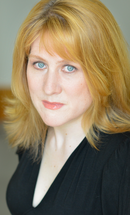
8. Tyger, Tyger! 3:48 by Martha Sullivan on text of William Blake
Conductor: Nathaniel Barnett
Soloist: Melissa Wozniak
Blake often used images of blacksmithing as a metaphor for Creation; in his own personal mythology, Los is the blacksmith Creator-God, and sometimes a stand-in for Blake himself. Such a god would naturally forge a creature as dangerous and full of fire as the tiger (the spelling “Tyger”, archaic even in Blake’s day, adds a tinge of danger and mystery). The pivotal question here is “Did he who made the Lamb make thee?”—the music highlights it by setting it at the end of a soaring but slightly slower section for solo soprano. Neither the poem nor the music answers that question, since it’s up to the individual to come to his or her own conclusions. As for the music, I wrote it mostly to be fun to sing. The music had to be challenging but manageable, and it had to have an interesting text. The challenges come from thick harmonies and fleet rhythms. All the notes fall within an unchanging mode (called Lydian Flat 7, or the Harmonic Series Mode), but this mode is a bit unusual and creates a few odd harmonies. Since the mode does not change, I reasoned, the notes should be easy to learn; a steady common-time meter also makes the music manageable, as does a catchy melody. I honored the strangeness of the text by using odd harmonies (the mode allows for minor/major sevenths and augmented/major sevenths) and an unsettled canon at the end, before finishing with a chord that simply lays an E major right on top of a D major chord in the same voicing ... this is a nod to Blake’s ambivalence about beauty and danger being knit into the same sinews by the same Creator. I am very grateful to C4 for its continued engagement with “Tyger! Tyger!”
—Martha Sullivan
For more on Martha Sullivan, see her web site, HERE
Tyger, Tyger! is available through See-A-Dot Music Publishing.
Conductor: Nathaniel Barnett
Soloist: Melissa Wozniak
Blake often used images of blacksmithing as a metaphor for Creation; in his own personal mythology, Los is the blacksmith Creator-God, and sometimes a stand-in for Blake himself. Such a god would naturally forge a creature as dangerous and full of fire as the tiger (the spelling “Tyger”, archaic even in Blake’s day, adds a tinge of danger and mystery). The pivotal question here is “Did he who made the Lamb make thee?”—the music highlights it by setting it at the end of a soaring but slightly slower section for solo soprano. Neither the poem nor the music answers that question, since it’s up to the individual to come to his or her own conclusions. As for the music, I wrote it mostly to be fun to sing. The music had to be challenging but manageable, and it had to have an interesting text. The challenges come from thick harmonies and fleet rhythms. All the notes fall within an unchanging mode (called Lydian Flat 7, or the Harmonic Series Mode), but this mode is a bit unusual and creates a few odd harmonies. Since the mode does not change, I reasoned, the notes should be easy to learn; a steady common-time meter also makes the music manageable, as does a catchy melody. I honored the strangeness of the text by using odd harmonies (the mode allows for minor/major sevenths and augmented/major sevenths) and an unsettled canon at the end, before finishing with a chord that simply lays an E major right on top of a D major chord in the same voicing ... this is a nod to Blake’s ambivalence about beauty and danger being knit into the same sinews by the same Creator. I am very grateful to C4 for its continued engagement with “Tyger! Tyger!”
—Martha Sullivan
For more on Martha Sullivan, see her web site, HERE
Tyger, Tyger! is available through See-A-Dot Music Publishing.
|
Tyger Tyger, burning bright,
In the forests of the night: What immortal hand or eye, Could frame thy fearful symmetry? In what distant deeps or skies, Burnt the fire of thine eyes? On what wings dare he aspire? What the hand, dare seize the fire? And what shoulder, & what art, Could twist the sinews of thy heart? And when thy heart began to beat, What dread hand? & what dread feet? |
What the hammer? what the chain?
In what furnace was thy brain? What the anvil? what dread grasp, Dare its deadly terrors clasp! When the stars threw down their spears And water’d heaven with their tears: Did he smile his work to see? Did he who made the Lamb make thee? Tyger Tyger, burning bright, In the forests of the night: What immortal hand or eye, Dare frame thy fearful symmetry? |

9. Tape Recorder 4:49 by Gordon Williamson on text of Zoë Skoulding
Conductor: Perry Townsend
Soloists: Melissa Wozniak, Jamie Klenetsky Fay,
Bettina Sheppard, Nathaniel Barnett, Daniel Andor-Ardó
I got to know Zoë Skoulding and her work at a recent artist residency in Paris, where I attended several of her readings. She has a distinctive delivery, almost stream of consciousness, that I found striking but really couldn’t imagine how to set to music. Within a few months I found that the idea of this challenge was still nagging at me, and so I took it up in working on this new piece for the C4 Ensemble. Skoulding’s poem “Tape Recorder” is ripe with clear musical themes and images, but also in its poetic description of sound which, for me, relates back to the particular experience of hearing her readings. In treating her text musically, I have borrowed some techniques from writing tape pieces: focusing on the sounds of consonants and vowels, replicating the depth of sound inherent in the tape medium, as well as using references to cutting, splicing, changes of speed and other elements of tape music. The resulting work is a roughly five-minute soundscape based on a ca. 15- to 20-second imagined reading by the poet, a time-stretch that allows for a closer examination of the various sound moments and images in a reading.
—Gordon Williamson
Get more information on Gordon Williamson, HERE
reel to reel beginning with
your own voice returning un-
like itself heavier and
thicker in rustles and clicks
of words outside the head where
a life may be erased with
its own sound replaying in
another room relatives
freeze up in the occasion
addressing a future that
doesn’t know them or a child
close to mic go on it’s like
a telephone but it won’t
say anything back hello

10. Love Is Anterior to Life 1:59 by Bettina Sheppard on text of Emily Dickinson
Conductor: Colin Britt
“Love Is Anterior to Life” is part of a larger song cycle of Emily Dickinson poetry settings originally performed at Hunter College’s Lang Recital Hall. Excerpts have since been included in concerts at Lincoln Center’s Alice Tully Hall and at New York City Center.
The four-line poem appears in Dickinson’s idiosyncratic style of broken textual lines interrupted by dashes. Each line is brilliantly separate and concise while allowing a sense of flow and eternity. Sopranos, altos, and tenors are each assigned one line with its own melody and metrical form, which is then repeated throughout. Only the basses sing the entire poem, while the second alto simply sings the word “love.” We feel the choppy nature of the poem with its distinct thoughts, but also the repetitive, eternal cycle of life and death.
—Bettina Sheppard
See more about Bettina Sheppard and her Vocal Arts Studio, HERE
Love Is Anterior to Life is available through See-A-Dot Music Publishing.
Love—is anterior to Life— Posterior—to Death— Initial of Creation, and The Exponent of Breath
Conductor: Colin Britt
“Love Is Anterior to Life” is part of a larger song cycle of Emily Dickinson poetry settings originally performed at Hunter College’s Lang Recital Hall. Excerpts have since been included in concerts at Lincoln Center’s Alice Tully Hall and at New York City Center.
The four-line poem appears in Dickinson’s idiosyncratic style of broken textual lines interrupted by dashes. Each line is brilliantly separate and concise while allowing a sense of flow and eternity. Sopranos, altos, and tenors are each assigned one line with its own melody and metrical form, which is then repeated throughout. Only the basses sing the entire poem, while the second alto simply sings the word “love.” We feel the choppy nature of the poem with its distinct thoughts, but also the repetitive, eternal cycle of life and death.
—Bettina Sheppard
See more about Bettina Sheppard and her Vocal Arts Studio, HERE
Love Is Anterior to Life is available through See-A-Dot Music Publishing.
Love—is anterior to Life— Posterior—to Death— Initial of Creation, and The Exponent of Breath

Allégories by Philippe Hersant on text of Arthur Rimbaud
11. Enfance III 4:40
12. Jeunesse III (vingt ans) 3:51
13. Départ 2:21
Conductor: Colin Britt
Soloists, Enfance III: Lorena Del Mar, Timothy Brown, Karen Siegel, Nathaniel Barnett
Soloists, Jeunesse III: Elizabeth Marker, Timothy Brown, Melissa Bybee, Nathaniel Barnett, Mario Gullo, Martha Sullivan
French composer Philippe Hersant’s music is both mystifying and accessible. His work Allégories, based on three of Rimbaud’s “Illuminations,” captures three varying stages of life in emotional and metaphorical expressions. The first, Childhood, is presented with a string of images observed in the world around us, depicted vividly with the composer’s haunting, nostalgic sound palette. The sound of the clock tolling provides a sonic carpet, over which the voices recite the various images.
The second movement, Youth, uses a repeating, warm refrain of the word “Adagio,” while the solo voices incant recitative-like wisps of the melodies. The movement seamlessly links to the third, moving into a jaunty triplet rhythm at the description of the hunt, which links thematically with the declamatory entrance of the final movement, Departure. In the final portion of the piece, the poet embraces death as the beginning of a new adventure – “departure into new affection and noise!”
—Colin Britt
Learn more about Philippe Hersant, HERE
Childhood III
There’s a bird in the woods, its song makes you stop and blush.
There’s a clock that never chimes.
There’s a hollow with a nest of white creatures. There’s a cathedral that descends, and a lake that rises.
There’s a little carriage abandoned in the copse, or running down the lane, beribboned.
There’s a troupe of little players in costume, glimpsed on the road through the edge of the woods.
There’s someone, at last, when you’re hungry and thirsty, who drives you away.
Youth III
20 years
The instructive voices exiled… physical ingenuousness bitterly stale…Adagio. Ah, the infinite egoism of adolescence, the studious optimism: how full the world was of flowers, that summer! The airs and the forms dying… A choir, to calm impotence and absence! A choir of glass with nocturnal melodies…
Indeed the nerves will soon be on the hunt.
Departure
Enough seen. The vision was encountered under all skies.
Enough had. Sounds of cities, evening, and in the light, and always.
Enough known. The decisions of life.
—O Sounds and Visions!
Departure into new affection and
noise!
11. Enfance III 4:40
12. Jeunesse III (vingt ans) 3:51
13. Départ 2:21
Conductor: Colin Britt
Soloists, Enfance III: Lorena Del Mar, Timothy Brown, Karen Siegel, Nathaniel Barnett
Soloists, Jeunesse III: Elizabeth Marker, Timothy Brown, Melissa Bybee, Nathaniel Barnett, Mario Gullo, Martha Sullivan
French composer Philippe Hersant’s music is both mystifying and accessible. His work Allégories, based on three of Rimbaud’s “Illuminations,” captures three varying stages of life in emotional and metaphorical expressions. The first, Childhood, is presented with a string of images observed in the world around us, depicted vividly with the composer’s haunting, nostalgic sound palette. The sound of the clock tolling provides a sonic carpet, over which the voices recite the various images.
The second movement, Youth, uses a repeating, warm refrain of the word “Adagio,” while the solo voices incant recitative-like wisps of the melodies. The movement seamlessly links to the third, moving into a jaunty triplet rhythm at the description of the hunt, which links thematically with the declamatory entrance of the final movement, Departure. In the final portion of the piece, the poet embraces death as the beginning of a new adventure – “departure into new affection and noise!”
—Colin Britt
Learn more about Philippe Hersant, HERE
Childhood III
There’s a bird in the woods, its song makes you stop and blush.
There’s a clock that never chimes.
There’s a hollow with a nest of white creatures. There’s a cathedral that descends, and a lake that rises.
There’s a little carriage abandoned in the copse, or running down the lane, beribboned.
There’s a troupe of little players in costume, glimpsed on the road through the edge of the woods.
There’s someone, at last, when you’re hungry and thirsty, who drives you away.
Youth III
20 years
The instructive voices exiled… physical ingenuousness bitterly stale…Adagio. Ah, the infinite egoism of adolescence, the studious optimism: how full the world was of flowers, that summer! The airs and the forms dying… A choir, to calm impotence and absence! A choir of glass with nocturnal melodies…
Indeed the nerves will soon be on the hunt.
Departure
Enough seen. The vision was encountered under all skies.
Enough had. Sounds of cities, evening, and in the light, and always.
Enough known. The decisions of life.
—O Sounds and Visions!
Departure into new affection and
noise!
The Ensemble for Cornerstones
|
Soprano
†Lorena Del Mar Rebecca Ehren †Priya Patil ‡Artemisz Polonyi †Karen Siegel ‡Julie Lauren Stevens Martha Sullivan Melissa Wozniak Alto Maya Ben-Meir Melissa Bybee Jamie Klenetsky Fay Elizabeth Marker Karl Saint Lucy Bettina Sheppard |
Tenor
Benjamin Arendsen Nathaniel Barnett Colin Britt Mario Gullo ‡Billy Janiszewski Perry Townsend Bass Daniel Andor-Ardó Hayes Biggs James Bilodeau Timothy Brown Brian Mountford David See † Tracks 4, 8–9, 11–13 ‡Tracks 1–3, 5–7, 10 |
Photos © by Keith Goldstein
|
2015-2016 "Cornerstones" CD Funders
|
“Cornerstones” Recording Sponsor
Bruce Saylor & Constance Beavon Daniel Sigg & Ellen Stafford-Sigg Cutting-Edge Circle Kit Smyth Basquin* Innovative Circle Susan M. Orzel-Biggs Ralph Crispino, Jr. Tammie Murphy David Wozniak Creative Circle Ted and Carol Barnett Jim Bilodeau Timothy Brown Joseph Fong Americanna Magness Joan Malczewski “Cornerstones” Recording Sponsor-$1,000-$4,999 Cutting-Edge Circle-$600-999 Innovative Circle-$350-599 Creative Circle-$125-349 Contemporary Circle-$1-$124 * Friend of C4 |
Contemporary Circle
Arianne M. Abela Richard Elder Adams Isabel Aleman Nick Allardice Aaron Alter Daniel Andor-Ardó László Andor Katherine Ardó Nathaniel Barnett Maya Ben-Meir Shareeza Bhola Michael Biello & Dan Martin Nina S. Bitton Vicki Borah Bloom Michael Blumenfeld Linda Britt Jeffrey Brown Maggie E. Brown Danielle Buonaiuto Lisa Burns Melissa Bybee Ching Chang Jessica Chen Brooke Collins Michael Dellaira Adam & Tara Levin Delson Dr. Alex DeLuca Mary & David Dreyfus Hugh & Kathy Klein Eddy Sue Jacobs Feingold Kenny Felder Jessica Foster Visha Fox Byron Gibbs* Mimi Goodman Beth Gordon Diane Gottlieb Martha Minetree Grasty Catherine Guthrie Rob Gutmann Brook Hersey Rochele Hirsch Maddie & Joe Hogan David Hurd Ling Hsaio Kamilah Jackson Jeffrey James David Keyes Jordan Kinsey Janet & Robert Klump Kermit Komm Jim & Lynne Kruszka Miriam & John Lafferty Patricia Larkin Cheryl Krugel-Lee & Jacob Lee The Levin-Delsons |
Contemporary Circle (Cont.)
Deborah Linehan Kellyn Loftus Donald McCloskey Maria McCumiskey Stella McKeown Angela Menghraj Mary Meyer Juliet Milhofer Mackenzie Millar Jean K. Monroe & Jay D. Lane Michele Taft Morris & Kate Dillingham Ian David Moss & Debby Katz Brian Mountford Louis & Sharon Mountford Ruth Mueller-Maerki Bernard & Rochelle Natt Lisa Niedermeyer Valerie Norton Tarik O’Regan Lois & George Orzel Leslie Palmer Janet B. Pascal Robert Paterson Jane Penn Helen E. Price Zahra Partovi* Eddie Quaid Bethany Reeves Debra Rich Mona Ring Brett Roelofs Suzanne & Jonathan Rosenzweig Joseph Rubinstein Maria E. Santos Peter Schmitt Gail Seiden Fahad Siadat Patricia Siegel Ike M. Silver Nancy Smardz Carolyn Smith Marcia Sofley Martin & Barbara Solomon Thomas Stumpf Martha Sullivan Anne Thulin* Mary Ellen Townsend Socrates James Triantafillou Bill Tribby Ludmila Trigos & Paul Judicke Joseph Upham* Jennifer Wentworth Gordon Williamson Ira Wolfman & Ronda Small Alice Wu Ruth Zeiner |
|
|
|
C4 is funded in part by:
C4 is a proud member of:
New York Choral Consortium |
Receive our newsletter:
Support C4's Mission!
|

